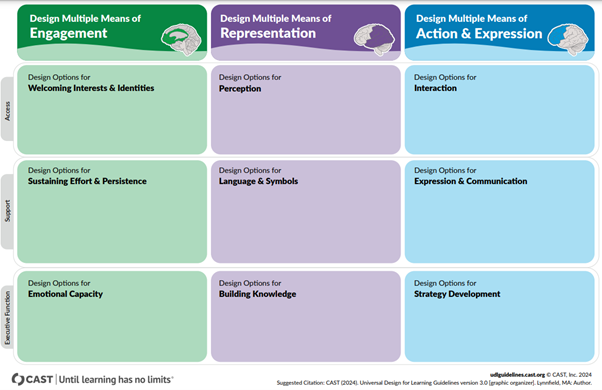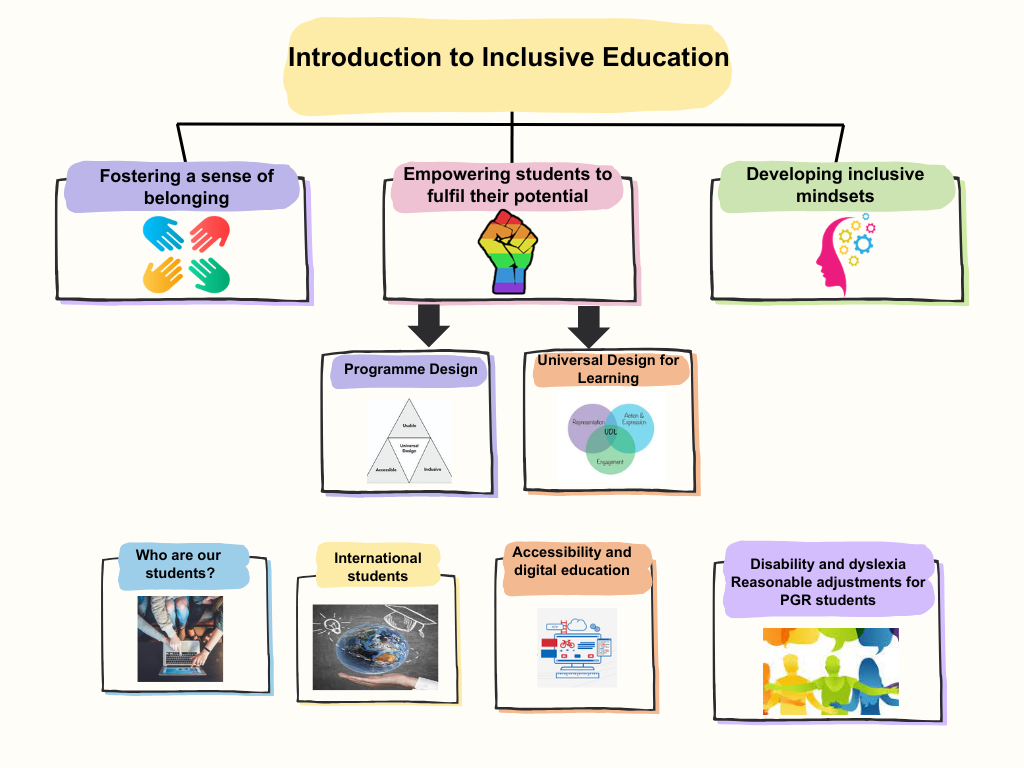Introduction
Universal Design for Learning
Inclusive education can be approached through the lens of Universal Design for Learning (UDL), as both intend to create a learning environment designed for a diversity of learners, rather than retrospectively making adaptations to accommodate specific students (Advance HE 2018).
Universal Design for Learning (UDL) is a set of principles for curriculum development that give all individuals equal opportunities to learn. The goal of UDL is learner agency that is purposeful and reflective, resourceful and authentic, strategic and action-oriented (CAST 2024). UDL provides a blueprint for creating instructional goals, methods, materials, and assessments that work for everyone – not a single, one-size-fits-all solution but rather a flexible approach that means learning can be customised and adjusted for individual identities and needs (UDL on Campus 2022).
UDL is thus a framework to guide the design of learning environments that are accessible, inclusive, equitable, and challenging for every learner. Ultimately, the goal of UDL is to support learner agency: the capacity to actively participate in making choices in order to meet learning goals. UDL aims to change the design of the environment rather than to situate the problem as a perceived deficit within the learner. The table in the Figure below presents the outline of the Universal Design for Learning Guidelines 3.0.

Figure: The UDL Guidelines 3.0. (A screen-readable alternative to the above table is available on this CAST page).
The UDL Guidelines are organised both horizontally and vertically. Vertically, the Guidelines are organised according to the three principles of UDL: engagement, representation, and action and expression. The principles are broken down into Guidelines, and each of these Guidelines have corresponding considerations that provide more detailed suggestions.
The Guidelines are also organised horizontally.
- The access row includes the guidelines that suggest ways to increase access to the learning goal by designing options for: welcoming interests and identities, perception, and interaction.
- The support row includes the guidelines that suggest ways to support the learning process by designing options for: effort and persistence, language and symbols, and expression and communication.
- Finally, the executive function row includes the guidelines that suggest ways to support learners’ executive functioning by designing options for: emotional capacity, building knowledge, and strategy development (CAST 2024).
Developing inclusive education through UDL also requires attention to culturally sustaining pedagogy, which addresses the need to diversify and decolonise the curriculum, to ensure all students recognise themselves in the curriculum, and are supported to be their authentic selves and achieve to their potential.
UDL suggests that it is essential to consider how structural dynamics influence learner agency. Designing learning environments that support learner agency requires continually examining power dynamics, by challenging structures that view the educator as the sole authority and creating space for learners to make sense of content individually and collectively through interaction and reflection. Further, supporting learner agency requires recognising dimensions of culture and identity and examining where bias may be a barrier to learners being able to fully exercise their agency (CAST 2024).
Remember: Inclusion is a process. Not all of the bullet points will be relevant to our discipline, our teaching, or our student diversity characteristics. Even one small change, such as ensuring a diversity of representation in your resources, materials available 48 hours in advance, providing a glossary, or catch up materials and recordings for those who miss opportunities for social learning, can change the experience of our students. Plan for quick wins and longer term goals!
Where Next?
Map of Topics
Below is a map of the toolkit and workshop topics, to aid your navigation. These will be developed and added to in future iterations of this toolkit:

You’re on page 6 of 9 Inclusivity theme pages. Explore the others here:
1.Inclusivity and the CU Inclusive Education Framework
2.Introduction to Inclusive Education
3.Fostering a sense of belonging for all students
4.Empowering students to fulfil their potential
5.Developing inclusive mindsets
6.Universal Design for Learning